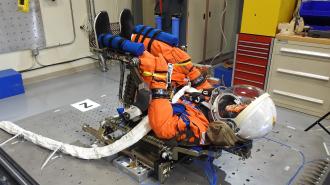On Saturday, September 3, NASA plans to launch its Space Launch System (SLS) for the first time — putting us one step closer to returning humans to the surface of the moon and eventually putting boots on Mars.
NASA had to scrub its first planned SLS launch attempt due to issues with an engine, but if this mission, Artemis 1, goes according to plan, an Orion capsule atop the SLS will be sent on a 42-day journey around the moon before returning to Earth.
The capsule will be uncrewed, but it won’t be empty. Here are three crucial science experiments about to embark on a lunar odyssey.
Commander Moonikin Campos and the phantoms
After Artemis 1, NASA plans to send two crewed Orion capsules to the moon over the next three years, and one goal of Artemis 1 is to collect data that will help ensure the safety of the astronauts involved in those missions.
As part of that objective, NASA is putting a manikin — an anatomical model of a human body — in the Orion capsule’s commander’s seat, which will be equipped with sensors to measure acceleration, vibration, and other environmental variables during the mission.
The manikin — dubbed “Commander Moonikin Campos” by a public naming contest — will be outfitted in one of the spacesuits NASA astronauts will wear during the crewed missions. This suit will include two sensors to measure radiation levels during the trip.
“It’s critical for us to get data from the Artemis I manikin to ensure all of the newly designed systems, coupled with an energy dampening system that the seats are mounted on, integrate together and provide the protection crew members will need in preparation for our first crewed mission on Artemis II,” said Jason Hutt, NASA lead for Orion Crew Systems Integration.
The Artemis 1 phantoms will be outfitted with more than 5,600 sensors.
The lower seats in the Orion capsule will be occupied by identical “phantoms” — manikin torsos made of materials that mimic the human body’s bones, organs, and soft tissues. These particular phantoms — named “Zohar” and “Helga” — will be outfitted with more than 5,600 sensors and will also help NASA prepare for the challenge of space radiation.
”Zohar will wear a radiation protection vest, called AstroRad, while Helga will not,” said NASA. “The study will provide valuable data on radiation levels astronauts may encounter on lunar missions and evaluate the effectiveness of the protective vest that could allow crew to exit the storm shelter and continue working on critical mission activities in spite of a solar storm.”

BioSentinel
While Helga, Zohar, and Moonikin Campos are designed to help NASA understand how space might affect astronauts, one Artemis 1 experiment will show scientists what being far from Earth actually does to a living organism: BioSentinel.
The BioSentinel experiment will be housed inside a CubeSat about the size of a cereal box. The tiny satellite will be deployed once the SLS reaches deep space and will then fly past the moon on its way into an orbit around the sun.
“BioSentinel is the first of its kind,” said Matthew Napoli, BioSentinel project manager. “It will carry living organisms farther into space than ever before.”
Once the BioSentinel satellite is past the moon, researchers will begin remotely triggering the hydration of dried yeast cells housed in small cards within the spacecraft.
“BioSentinel can help us better understand the radiation risks for long-duration deep space human exploration.”
NASA
Each card will contain two strains of yeast: one “normal” strain to serve as a control and one strain engineered to have difficulty repairing damage to its DNA. These cards will be activated at different times during the 6-12 month long experiment.
One instrument aboard BioSentinel will measure radiation levels, while another — the “BioSensor” — will collect data on the yeast, measuring their growth and activity in response to the radiation environment.
“Because human cells and yeast cells have many similar biological mechanisms, including for DNA damage and repair, BioSentinel’s experiments can help us better understand the radiation risks for long-duration deep space human exploration,” said NASA.

OMOTENASHI
BioSentinel is just one of 10 CubeSats set for deployment during the Artemis 1 mission. While it’s the only experiment that contains living organisms, one designed by the Japanese Aerospace Exploration Agency (JAXA) will be the only one to attempt a moon landing.
After separating from the SLS, JAXA’s OMEOTENASHI (Outstanding MOon exploration Technologies demonstrated by NAno Semi-Hard Impactor) will enter lunar orbit. It’ll then use a single rocket motor to slow its descent before making a “semi-hard” landing on the moon’s surface.
If all goes according to plan, the spacecraft will be able to survive this impact thanks to an inflatable airbag and shock-absorption system — and survival is really the main point of the mission.
“In the near future, industry, academia, and even individuals will be able to, and should, easily participate in space exploration.”
Tatsuaki Hashimoto
If OMEOTENASHI makes it to the lunar surface intact, Japan will become the fourth nation to successfully land a spacecraft on the moon. At just 30 pounds, OMEOTENASHI will also be the smallest lunar lander ever, and JAXA hopes its success will help increase access to the lunar surface.
“In the near future, industry, academia, and even individuals will be able to, and should, easily participate in space exploration,” said Tatsuaki Hashimoto, OMOTENASHI’s principal investigator, in 2016. “To realize such a world, small and low-cost spacecraft will be indispensable.”
As a secondary objective, OMEOTENASHI will also collect data on space radiation — we really can’t be over-prepared when it comes to protecting our astronauts during Artemis 2 and 3.

We’d love to hear from you! If you have a comment about this article or if you have a tip for a future Freethink story, please email us at [email protected].




